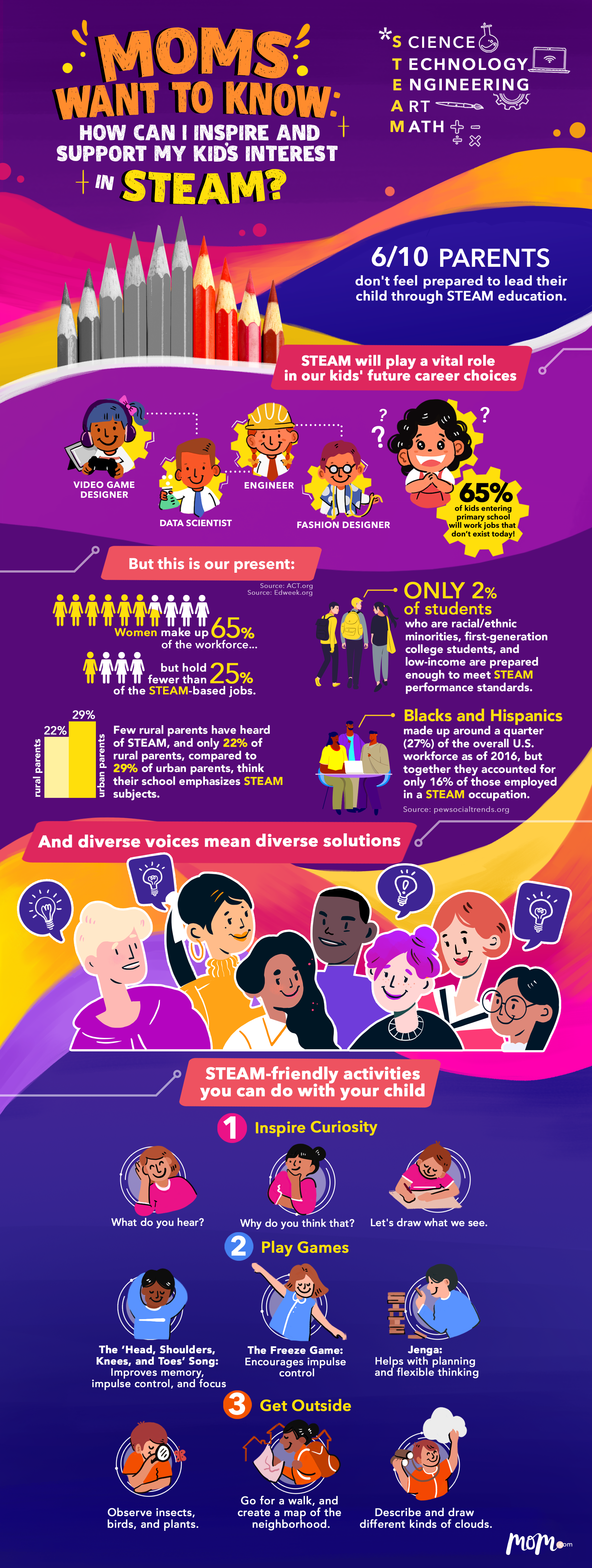
When it comes to STEAM — the educational movement whose letters stand for science, technology, engineering, art, and math — many parents are at a loss for how to effectively teach their kids about it at home, much less make it interesting.
In fact, a recent survey conducted by Mom.com found that six out of 10 parents admitted they don't feel prepared to lead their child through STEAM education. (Check out more interesting stats in our infographic below.)
But with jobs focused on the STEM part of the acronym gaining more traction in the US — set to increase 17% between 2014 and 2024, compared with 12% for non-STEM jobs, according to Wired — parents have an incentive to make sure these opportunities aren’t lost on their children.
Think about it: A job opening for a social media manager seemed almost laughable a mere 10 years ago. We can still hear the incredulity now: Is that even a real job? Yes. Yes, it is. Are you cringing just a little?

Here we are today, with Facebook, Instagram, and Snapchat harnessing literally billions of users and holding the financial fates of many mainstream companies in the palms of their users' smartphone-obsessed hands. The social media managers are laughing all the way to the Bitcoin bank; same with new C-suite-titled execs — you know, the chief innovation officers and chief culture officers of today's modern world.
That's why, parents, we need to fully get on this, ahem, STEAM train. Because it’s not only social media: 65% of kids entering primary school will have job titles that don’t exist today.
That stat is both exciting and terrifying, because it not only leaves the door open for tremendous opportunity, it also presents an unknown to parents who are already busy managing the day-to-day challenges of homework, extracurriculars, household, and career. Now, we're being tasked with paving the way for something that doesn’t yet exist?
We get it: It’s a tall and daunting order. But it doesn’t have to be.
I was recently talking to a very insightful 19-year-old entering his second year of college. He brought up Apple and what makes STEAM — the one with “art” in the name — so important.
It was the design, he said, marveling at the beauty and simplicity of the now-ubiquitous phone that literally changed the world. People didn’t buy the device because of its amazing CPU processor or memory size, he argued. Sure, that was part of it for some people, but millions of consumers invested in that first iPhone because it looked amazing and fulfilled more of their needs in a brand-new way. It was art working in beautiful harmony with science, tech, engineering, and, yes, math.
As parents, we need to help pave the way for our kids to feel comfortable in those fields, to feel as if those career paths are accessible to them — and not just some of them, all of them.
After all, despite women making up nearly half of the US workforce (and half of the college-educated workforce), they hold fewer than 25% of STEM jobs in this country. The numbers for black and hispanic workers are even more staggering.
While schools work hard to bring STEM and STEAM into their curricula, and fashion places like makers’ labs and innovation labs out of large closets and old art rooms, parents also have the opportunity to inspire and support their children in these areas at home. No labs required.
It can start with simple activities that can be woven into your everyday life, between homework, practice, and the myriad appointments and birthday parties that dominate the calendar.
What are they?
- Inspire curiosity. That is, ask questions and initiate activities that invite kids to use all of their senses. “What do you hear?” “Why do you think that?” “Let’s draw what we can see.”
- Play games. For little ones, the “Head, Shoulders, Knees, and Toes” game helps improve memory, impulse control, and focus.
- Get outside. Observe nature. Look at insects, plants, and birds. Go for a walk, and make a map of the neighborhood. Describe and draw a variety of clouds.
Basically, fire up your kids’ imaginations. Set their wheels in motion. Get them excited about the world around them.
Because they are the ones who will be shaping our world, creating jobs, hiring for jobs that don’t yet exist, and developing products that will blow our minds.
Let’s not only tell them about it. Let’s help them to excel there, too. After all, they could be the next big tech designer or chief ideas officer. That's right. Go ahead, and tell them to make that a thing.







